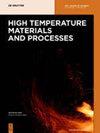Dephosphorization kinetics of high-P-containing reduced iron produced from oolitic hematite ore
IF 1.5
4区 材料科学
Q4 MATERIALS SCIENCE, MULTIDISCIPLINARY
引用次数: 0
Abstract
Abstract To comprehensively utilize Fe and P in oolitic hematite ore, an innovative method was proposed to enhance P enrichment in the reduced iron during the reduction process. The reduced iron was then converted to low-P-containing molten iron and high-P-containing slag in the presence of CaO–SiO2–FeO–Al2O3 slag. In this study, the P content of the final iron after 0–1,800 s dephosphorization was investigated at different slag composition conditions, and the dephosphorization kinetics of the reduced iron was analyzed. The results showed that the P content of the final iron sample decreased rapidly within 600 s of dephosphorization and became almost constant with increasing dephosphorization time to 1,800 s. The basicity, FeO content, and Al2O3 content also affected the dephosphorization rate of the reduced iron. The apparent dephosphorization rate constant ranged from 1.141 × 10−3 to 2.363 × 10−3 g·(cm2·s)−1, and the overall mass transfer coefficient ranged from 2.47 × 10−3 to 3.38 × 10−3 cm·s−1. The rate-controlling step of the dephosphorization process was the mass transfer of P in both the slag and iron phases. The findings of this study provide a theoretical basis for the utilization of refractory oolitic hematite ore.鲕状赤铁矿高含磷还原铁脱磷动力学研究
摘要为了综合利用鲕状赤铁矿中的铁和磷,提出了一种在还原过程中提高还原铁中磷富集度的创新方法。然后,在CaO–SiO2–FeO–Al2O3渣的存在下,还原的铁转化为低磷铁水和高磷渣。在本研究中,研究了不同炉渣成分条件下0–1800 s脱磷后最终铁的磷含量,并分析了还原铁的脱磷动力学。结果表明,最终铁样品中的磷含量在600以内迅速下降 s,并且随着脱磷时间增加到1800而几乎不变 s.碱度、FeO含量和Al2O3含量也影响还原铁的脱磷率。表观脱磷速率常数为1.141×10−3~2.363×10− g·(cm2·s)−1,总传质系数为2.47×10−3至3.38×10− cm·s−1。脱磷过程的速率控制步骤是磷在渣相和铁相中的传质。研究结果为难选鲕状赤铁矿的开发利用提供了理论依据。
本文章由计算机程序翻译,如有差异,请以英文原文为准。
求助全文
约1分钟内获得全文
求助全文
来源期刊

High Temperature Materials and Processes
工程技术-材料科学:综合
CiteScore
2.50
自引率
0.00%
发文量
42
审稿时长
3.9 months
期刊介绍:
High Temperature Materials and Processes offers an international publication forum for new ideas, insights and results related to high-temperature materials and processes in science and technology. The journal publishes original research papers and short communications addressing topics at the forefront of high-temperature materials research including processing of various materials at high temperatures. Occasionally, reviews of a specific topic are included. The journal also publishes special issues featuring ongoing research programs as well as symposia of high-temperature materials and processes, and other related research activities.
Emphasis is placed on the multi-disciplinary nature of high-temperature materials and processes for various materials in a variety of states. Such a nature of the journal will help readers who wish to become acquainted with related subjects by obtaining information of various aspects of high-temperature materials research. The increasing spread of information on these subjects will also help to shed light on relevant topics of high-temperature materials and processes outside of readers’ own core specialties.
 求助内容:
求助内容: 应助结果提醒方式:
应助结果提醒方式:


